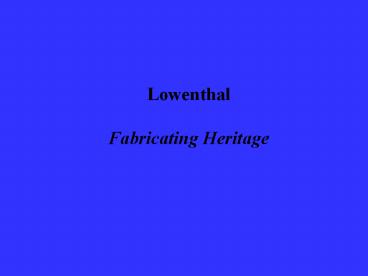Lowenthal Fabricating Heritage - PowerPoint PPT Presentation
Title:
Lowenthal Fabricating Heritage
Description:
Discussion. 1. Lowenthal gives a case study as an example of 'fabricating heritage' ... Discussion ... Discussion. 5. 'Heritage thrives on historical error! ... – PowerPoint PPT presentation
Number of Views:89
Avg rating:3.0/5.0
Title: Lowenthal Fabricating Heritage
1
Lowenthal Fabricating Heritage
2
Discussion
- 1. Lowenthal gives a case study as an example of
'fabricating heritage'. - Give comparable examples from your knowledge and
discuss the following - the heritage myth itself
- the occasion at which its origin can be traced
- infer the purposes
- what individuals/institutions are promulgating
this myth - what are the mechanisms by which this myth is
recycled within popular imagination - the changes that it has undergone over time
- your sources
3
Discussion
- 2. If heritage today has the nature of popular
cult, with unwavering public devotion in spite of
realities that show its contradictions, what are
the vehicles by which it is maintained? - How does this process differ from say medieval
cults of relics (of which Lowenthal gives an
example)?
4
Discussion
- 3. What are the benefits of heritage myths for
societies? What are the dangers? Who are the
potential myth debunkers in the society? - 4. What is the role of the memory institutions in
relation to myth-building (fabrication)? Give
examples that show how the worship of the past
may become a secular religion in the society and
the role of these institutions in maintaining
such legacies. Is it possible for memory
institutions to avoid "morality" in interpreting
the past?
5
Discussion
- 5. "Heritage thrives on historical error!" //
"Tribulations are crucial to identity" //
(Lowenthal, p. 11). Explain these paradoxes! - 6. "We want the Smithsonian to reflect real
America and not something that a historian
dreamed up." (Lowenthal, 11). How does this
statement relate to building library collections,
archival practices, and the museum work.
6
Discussion
- 7. "Time makes liars of all of us!" (Lowenthal,
16). - Do you agree? How does this statement relate to
the role of memory institutions in society? How
does this relate to how they manage the relation
of records and memory access to written past? - 8. Heritage and history are both built upon the
knowledge of the past. The readings and
misreadings of the past, the correct and the
false knowledge of the past are integral to both,
but what is the difference in the process? You
may use the example of Biblical textual tradition
/ scholarship to discuss this distinction, or use
a comparable example.
7
Discussion
- 9. Lowenthal identifies six points that
distinguish heritage as a phenomenon - HERITAGE IS NOT HISTORY (how heritage differs
from history) - FABRICATION ESSENTIAL TO FEALTY (why heritage
needs error and invention) - MODES OF FABRICATION (how heritage reshapes the
past upgrades, updates, jumbles, selectively
forgets, contrives genealogies, claims
precedence) - PUBLIC ENDORSEMENT (public approval of
fabrication) - HERITAGE AND LIFE HISTORY (autobiographical
analogies) - WHY HERITAGE MUST BE 'OURS' (need to own our
own heritage) - Briefly explain each of these aspects of
'heritage' and give your own examples that either
agree or contradict Lowenthal's position.
8
Global Culture, Modern Heritage Remembering the
Chinese Imperial Collections(Hamlish 2000)
9
Discussion
- Chinese Imperial Collections and the Palace
Museum (Beijing) - construction of collective memory in the Palace
Museum - typical of the conceptual structure of museums
- museums present polysemic possibilities
(constructing various narratives from single
collections) - visitors journey (controlled movement) along two
pathways YUAN ZHUANG CHENLIE (period rooms)
ZHUAN TI CHENLIE (exhibit halls)
10
Discussion
- YUAN ZHUANG CHENLIE (period rooms) functional
grouping of objects reconstruction only of Qing
Ming Dynasty period visitors response
appropriation palace intrigue, gossip, everyday
life, popular imagery extension of tourist trade
and sensationalized accounts - ZHUAN TI CHENLIE (exhibit halls) objects grouped
by type subdivided by chronology to demonstrate
historical development in technology
aesthetics
11
Discussion
- How are these two displays complementary? How
does each display contribute to the construction
of the imperial past? - What is the function of collective
representations? How is memory related to
political legitimacy on the global and the local
level (p. 150)? - What is the meaning of break dancers and their
appropriation of the public space in Liu Yirans
short story, Rocking Tiananmen? - What are the implications of the existence of
UNESCOs World Heritage Center for
conceptualizing heritage at the global/local
level? In that context, discuss the notion of
universalizing rhetoric or erasure of difference
(p. 157)?































